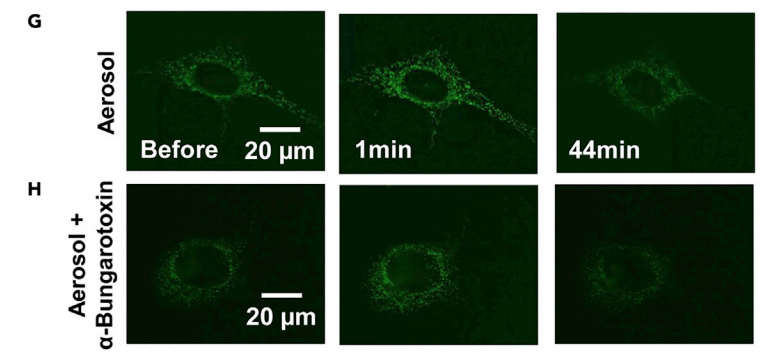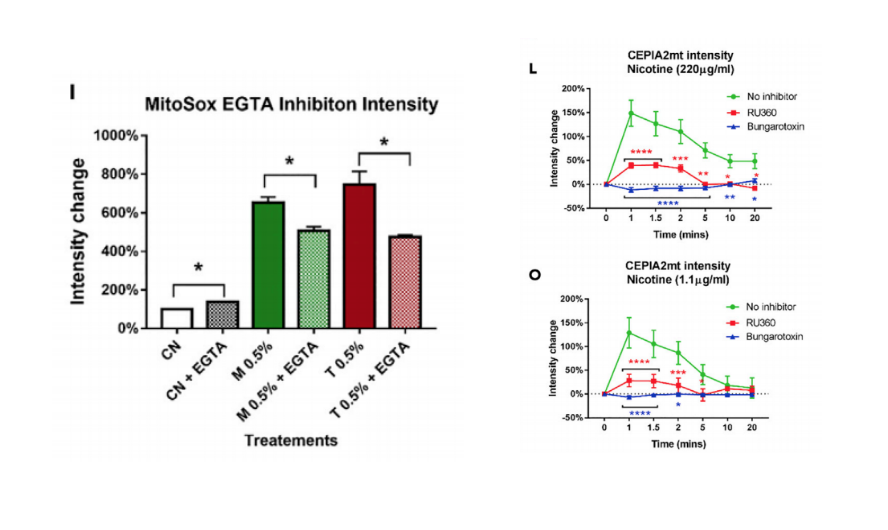64 5.10: Role of Nicotine
Overview
This section focuses on the effects of nicotine on mitochondrial stress response in neural stem cells. These effects occur independent of electronic cigarettes.
Protein Oxidation and Mitochondrial Hyperfusion
MitoSOX red fluorescence reveals increased intensity in nicotine treated groups suggesting significant superoxide elevation. Mitotimer neural stem cells treated with nicotine shows an increase in red compared to green fluorescent ratio which suggests that protein oxidation is increased. In addition, the mitochondrial morphologies show an increase in networked mitochondria and decrease in punctuate mitochondria which serves as evidence for stress induced mitochondrial hyperfusion or SIMH (Zahedi et al., 2019).

Plasma Membrane Retraction and Intracellular Calcium Overload
Nicotinic acetylcholine receptors (nAChRs) on cell membranes of the central nervous system can become activated by nicotine resulting in an influx of calcium (Ca2+). Green fluorescent calcium reporter GCaMP5 can be used to visualize calcium levels. In the nicotine treatment group, calcium levels are more intense at the perinuclear region (endoplasmic reticulum). Plasma membrane retraction at cell-cell contacts are apparent and result in some retractions pinching off forming small extracellular fragments with increased calcium levels. This process promotes intracellular calcium overload (Zahedi et al., 2019).

Calcium Influx and Mitochondrial Damage
Calcium accumulation in the mitochondria can result in ROS production. Calcium-measuring organelle-entrapped protein indicator (CEPIA) fluorescence can be used to visualize calcium levels. Fluorescence persists in the nicotine treatment group without returning to a resting state. This is indicative of persistent elevation of mitochondrial calcium. To fully understand the role of calcium influx on mitochondrial damage, three calcium blocking experiments can be conducted. Mitochondrial calcium uniporter (MCU) can be blocked through neural stem cell treatment with Ru360 (MCU binding complex). Additionally, a7 Nicotinic acetylcholine receptors (nAChRs) at the cell and mitochondrial membranes can be blocked through antagonist a-bungarotoxin in CEPIA2mt fluorescent neural stem cell treatment groups. Calcium chelator EGTA can also be used along with MitoSOX red fluorescent dye to visualize calcium blockage in neural stem cell treatment groups. In all cases, fluorescence and thus intracellular calcium levels are decreased which reveals significant decrease in mitochondrial superoxide levels. This suggests that calcium overload contributes to electronic cigarette induced mitochondrial defects (Zahedi et al., 2019).


Key Takeaways
Nicotine alone can cause:
- Increased protein oxidation and hyperfusion
- Increased calcium overload and plasma membrane retraction
Calcium experiments showed:
- Decreased superoxide levels in the presence of calcium inhibitors
- This confirmed the link between nicotine induced calcium influx and mitochondrial damage
